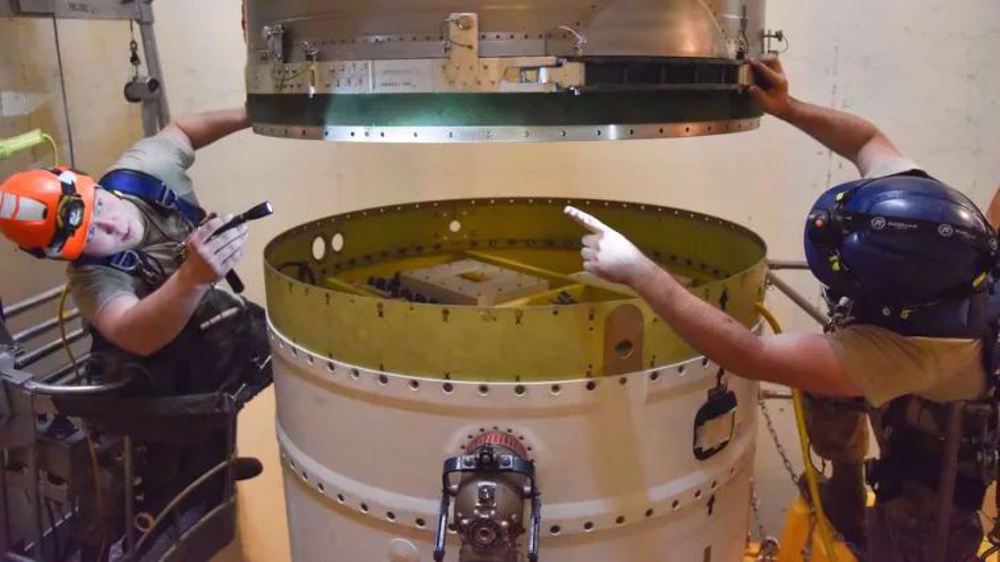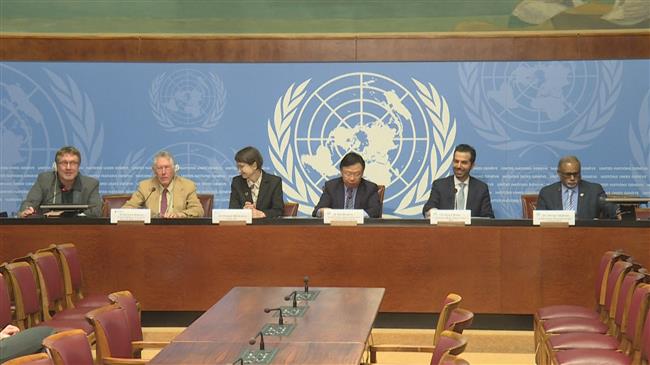Cancerous missiles: US nuke missile sites as breeding grounds for cancer
By Reza Javadi
Unsafe levels of carcinogens were recently detected at a US nuclear missile base in western Montana state where a large number of people had earlier been diagnosed with cancer, sending ripples of fear and anxiety.
The US Air Force found the Carcinogenic substance at two underground launch control centers at Malmstrom Air Force Base in Montana, where polychlorinated biphenyls (PCB) levels were reported to be higher than the thresholds recommended by the Environmental Protection Agency (EPA).
According to Air Force Global Strike Command’s statement, the discovery “is the first from an extensive sampling of active U.S. intercontinental ballistic missile bases to address specific cancer concerns raised by missile community members.”
Considering the hazardous level of the PCBs, which are oily or waxy Carcinogenic substances that cause blood cancer, Gen. Thomas Bussiere, commander of Air Force Global Strike Command, ordered "immediate measures to begin the cleanup process for the affected facilities and mitigate exposure by our Airmen and Guardians to potentially hazardous conditions."
Following the damning report, fears have mounted about the existence of similarly dangerous substances in other military sites across the US, contributing to the cases of cancer, according to data from a grassroots group of former missile launch officers and their surviving family members.
The Air Force School of Aerospace Medicine has launched an investigation to look at cancer cases among the missile community after a military briefing in January showed that at least nine current or former missileers at Malmstrom were diagnosed with non-Hodgkin lymphoma, a rare blood cancer.
Rate of cancers surging in US
According to the American Cancer Society, an average of 19 cases of non-Hodgkin’s lymphoma is diagnosed each year in the US for every 100,000 people. The Centers for Disease Control and Prevention (CDC) says there are about 403 new cancer cases reported per 100,000 people each year.
Moreover, according to the Torchlight Initiative, an NGO composed of current and former ICBM community, at least 268 missileer troops or their surviving family members have contracted cancer, blood diseases, or other illnesses over the past several decades.
It is worth noting that more than 21,000 servicemen are working as missileers at the country's three silo-launched Minuteman III intercontinental ballistic missile bases at Malmstrom, FE Warren Air Force Base in Wyoming and Minot Air Force Base in North Dakota, who spend days together on monitoring and, if needed, launching fields of silo-based nuclear weapons.
Being exposed to Carcinogenic materials by thousands of these troops and their family members could bring another scandal for the US and its nuclear activities, experts believe.
The development comes as missileers had warned multiple times over the years about several defects including ventilation issues, water quality, and potential toxins they could not avoid during their duty.
Environmental impact of nuke activities
Apart from human beings, the nuclear activities by the US Department of Defense and the Department of Energy have also affected wildlife and the natural environment.
For instance, the Hanford Nuclear Site, which is located in eastern Washington State, produced tons of plutonium for use in the atomic weapon program, releasing significant quantities of waste containing hazardous chemicals and radioactive materials and dislodging them into the land and water, including into the Columbia River, posing a significant threat to fish and wildlife and their habitat.
People around the Hanford Nuclear Site are also subject to severe lung diseases, as they inhale the toxic odors released from the site, according to reports.
The chemical and nuclear waste from the nuclear site is stored in 177 underground tanks. However, according to NBC’s report, the tanks have been leaking, and the vapors they emit contain toxic and radioactive chemicals known to cause cancer and brain and lung damage.
An estimated 1 million gallons of liquid waste have leaked from tanks into the ground, threatening the Columbia River and the ecological environment around it. Radioactive trash still litters parts of Hanford.
Some nuclear experts have called Hanford "the most toxic place in America" and "an underground Chernobyl waiting to happen."
According to a report by the US Government Accountability Office (GAO), total cleanup costs at Hanford are projected to reach up to US$640 billion, and the job won’t be completed for decades, if ever.
Department of Energy as source of threat
According to the DOE, as cited by NBC News, the site "cannot effectively control" dangers and gives workers "no warning."
However, observers accuse the department of inaction and say it is not doing enough to act on its own findings and continues to put workers at risk.
Local neuropsychologist Brian Campbell, who had evaluated 29 people at Hanford with both respiratory and cognitive symptoms, said he witnessed "some of the worst cases of dementia that I've seen in young people, which we do not anticipate."
"More likely than not," said Campbell, "I think it's caused by the exposure they had at Hanford."
Calling the US government's response to the issue "an absolute scandal", Lt. Gov. Cyrus Habib told NBC News: "When you think about the risk not only to workers but also to our water supply, it's like a Stephen King novel. This is something that I think everyone in the country should be thinking about."
Attorney General Bob Ferguson took an even more unusual step in 2016, suing the federal government.
“To be candid, they have to live with themselves on that," said Ferguson. "I ask the question all the time, 'How many more workers have to get sick at Hanford before they do something about it? How many?' Please ask them. I really want to know."
Susannah Frame, investigative reporter at Seattle NBC affiliate KING, says the risk goes beyond workers at the site and includes the risk of a possible tank explosion and the subsequent contamination of a larger area.
"Our lives don't matter," said Seth Ellingsworth. "Our health does not matter. We are simply a business decision. It costs more money to protect us than to fight us, to deal with us being sick."
Victims of US nuke activities
A new study on the victims of US nuclear activities, released in July 2023, has found that fallout from the Trinity nuclear test reached 46 US states as well as some parts of Canada and Mexico.
In an article published by The Conversation, William J. Kinsella, a professor emeritus of communication at North Carolina State University, stated that the US government’s principle of secrecy has “shrouded nuclear weapons activities from their inception.”
In a disastrous act in the 1940s and 1950s, revealed later in New York Times, Hanford’s managers knowingly released toxic gases into the air, contaminating farmlands and pastures downwind.
Without imagining the scale and scope of the disastrous outcomes, currently active nuclear weapons sites, including Los Alamos National Laboratory, are still busy manufacturing atomic weapons, seeing their share of nuclear and toxic chemical contamination.
While continuing its own devastating nuclear activities, the US government has been busy pointing fingers at countries such as Iran, which have been carrying out peaceful nuclear energy programs.
Iran, along with other West Asian nations, supports a nuclear-weapon-free zone in West Asia. However, the US policy to back the nuclear-armed Israeli regime has created a big hurdle in non-proliferation.
Back in 2012, the US unilaterally decided to cancel the 2012 NTP review meeting, saying “states in the region have not reached agreement on acceptable conditions for a conference” and again in 2015 it brazenly disagreed with a nuke-free West Asia.
Washington not only provides nuclear arms to the Israeli regime but also asks other neighboring states to stop proliferating, threatening them with military action.
Iran reiterates rejection of interventionist stances on its territorial integrity
US 'lethal' strikes target two vessels as Trump warns of possible war with Venezuela
VIDEO | Press TV's news headlines
VIDEO | Indian leather industry eyes Russian, African markets amid US tariffs
Lavrov urges IAEA chief to adhere to neutrality, objectivity towards Iran
7 Palestinians killed after Israel strikes Gaza school
US Navy test launches replication of Iranian drone Shahed-136
Iran slams Canada’s sanctions as ‘baseless’ and ‘meddlesome’















 This makes it easy to access the Press TV website
This makes it easy to access the Press TV website